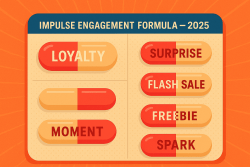
Loyalty is Changing: Moment-Based Strategies Now Matter in both B2C and B2B.
Loyalty used to be earned. You signed up, collected points, climbed tiers, and waited patiently for a reward. But in 2025, the old rules no longer apply. Today’s consumers (and increasingly, business buyers) want something different – not a promise of value in six months, but a moment of unexpected joy right now. This is the era of dopamine loyalty, where habits are hijacked, emotions are engineered, and loyalty isn’t built over time, but triggered in an instant.
Why This Matters in 2025
In a region shaped by TikTok commerce, gamified apps, and 8-second attention spans, brands have had to adapt fast. Loyalty is no longer about transactions over time, but about the feeling you create in the moment. This isn’t just a B2C story – business buyers are consumers too. They’re on the same dopamine-driven platforms, conditioned by the same algorithms, and increasingly they expect the same responsiveness and thrill from the brands they work with professionally. If your B2B brand still runs a traditional loyalty program (or worse, none at all) you’re missing this shift entirely.
The Collapse of Traditional Loyalty
73% of Gen Alpha consumers say they would rather get a surprise perk today than a 10% discount in six months.” – McKinsey, 2025.
This statistic doesn’t just spell trouble for supermarket rewards; it challenges the entire premise of deferred gratification in brand engagement. Today’s most effective loyalty mechanics are designed to embrace immediacy, unpredictability, and emotion. The psychology is well documented: variable rewards trigger dopamine. Like slot machines or swipe-based dating apps, unpredictable rewards reinforce behaviour faster and more powerfully than predictable ones.
The Rise of Moment Brands
We’re now seeing more brands that don’t just ask patiently for loyalty – they spark it. From Duolingo’s Streak Surprises to Prime’s Lightning Loot, these are moment brands that win by combining by long-term stickiness with knowing exactly when and how to pounce. In Southeast Asia, this hybrid loyalty model is already mainstream. Brands like Shopee, Grab, and Lazada mix slow-burn mechanics (coins, tiers, daily check-ins) with dopamine drops like spin-the-wheel discounts, flash sales, and viral surprise perks.

B2B Brands Getting in on the Act
At first glance, moment-based engagement feels like a consumer tactic. But today’s B2B buyers are TikTok users and Grab riders too:
- They expect instant responses
- They crave emotional micro-moments
- Thy share wins and seek validation just like any consumer
Smart B2B brands are catching on through:
- Surprise access to beta features
- One-off trial drops during product launches
- Gamified learning paths with real-world perks
This isn’t just about perks. It’s a shift toward professional delight – making even rational decision-makers feel seen, rewarded, and energized.
The Hybrid Loyalty Playbook: Slow-Burn & Dopamine Rush
The best strategies now layer habitual loyalty systems with spontaneous emotional triggers.
- Tactic #1 – Streak Surprises: Reward consistent behaviour with an unexpected bonus. E.g., “Attended three webinars this quarter? Here’s an invite to our private AI tools beta.”
- Tactic #2 – Reverse Loyalty: Reward non-transactional behaviours. E.g., “You shared our whitepaper five times—here’s a one-on-one session with our founder.”
- Tactic #3 – Social Dopamine:Let users share their wins. E.g., “Unlock a reward, then boost its value by inviting a peer to your Slack workspace.”
In Southeast Asia, it can be said that these strategies are amplified by some aspects of the prevailing cultures, with community-driven trust, collectivism, and social sharing already baked in to many societal norms. The viral loops are stronger, the urgency is higher, and the expectation of fun is greater.
The Risk: Sustaining the High
Too much “wow” can eventually turn into meh. If every week is a surprise, none of them are special. Dopamine loyalty must be paced and personalized. In this respect, access to data gives B2B brands have an edge. Unlike consumer brands, B2B often knows exactly where each customer is in the journey. This opens the door for hyper-targeted micro-rewards that actually feel meaningful – timely, context-aware nudges that say, “Hey, we see you. Here’s something just for you.”
What Agencies Need to Do Now
Agencies – and brand strategists – need to rewire how we think about engagement. Whether you’re working with a B2C brand in Jakarta or a B2B platform in Singapore, the principles are converging:
- Design for emotion, not just logic
- Create moments that feel human and immediate
- Balance consistency with surprise
It’s not just about building loyalty programs anymore. It’s about designing emotional feedback loops. We’re creating experiences people want to share. And in 2025, those experiences might be the only thing that keeps your brand in someone’s mental playlist – whether they’re in the market for shampoo, front-row seats, or enterprise software.